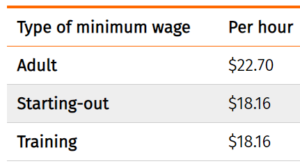What is the minimum wage?
As of April 2023, the minimum wage in New Zealand gas been $22.70 an hour. However, some exclusions apply for those who are training, just starting-out or under 16 years of age.
The minimum wage exists to ensure that workers earn enough for them to meet their basic needs. The minimum wage also acts as an incentive for individuals to seek employment, and ensures that employers pay their workers a fair wage.
See the table below for current minimum wage rates for those aged 16+.

Who earns the minimum wage?
The minimum rates apply to all employees. It doesn’t matter if they work full-time, part-time or casually. It also applies whether they are paid an hourly rate, a salary, on a commission basis, or a piece rate.
However, if an employee is under the age of 16, they are not entitled to the adult minimum wage.
What is the starting-out minimum wage?
The starting-out minimum wage applies to workers who are:
- 16- and 17-year-old employees who haven’t done six months of continuous employment service with their current employer. After six months with one employer they must be paid the adult minimum wage
- 18- and 19 year-old employees who have been paid one or more social security benefits for 6+ months, and who haven’t completed six months’ continuous employment with an employer since they started being paid a benefit
What is the training minimum wage?
The training minimum wage applies to employees aged 20+ years and who need at least 60 credits a year of an industry training program to become qualified in the area they are working in. Many of these employees will be apprentices.
What if I’m under 16?
There is no minimum wage for those who are aged 15 or younger. The hourly wage is up to the employer. However, all the other minimum standards and employment rights and obligations apply. When an employee turns 16, they must be paid the relevant minimum wage.
There are limits to what jobs under 16s can have and the hours they are permitted to work. For instance, school-aged students can only work outside of school hours, and not between 10pm and 6am.
More information can be found here.
Minimum wage vs living wage
Although the minimum wage has increased by almost $7 in the past six years, it still sits below the Living Wage of $26 per hour. The Living Wage is a figure set by the Living Wage Movement, and is paid by many employers voluntarily. For more on the Living Wage, and a list of accredited employers, click here.
Everyday and savings accounts
Looking to maximise your money? Click here to see compare savings accounts, everyday accounts and the most recent winners of Canstar’s Outstanding Value | Everyday and Savings Accounts awards.
About the author of this page
This report was written by Canstar Content Producer, Caitlin Bingham. Caitlin is an experienced writer whose passion for creativity led her to study communication and journalism. She began her career freelancing as a content writer, before joining the Canstar team.
Enjoy reading this article?
You can like us on Facebook and get social, or sign up to receive more news like this straight to your inbox.
By subscribing you agree to the Canstar Privacy Policy




Share this article